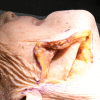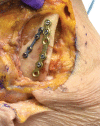Surgical Simulation Course for Facial Fracture Education
- PMID: 33552813
- PMCID: PMC7859082
- DOI: 10.1097/GOX.0000000000003353
Surgical Simulation Course for Facial Fracture Education
Abstract
A hands-on facial fracture simulation course can be an important adjunct teaching modality in resident education and training, enhancing both resident confidence and competence in treatment of facial fractures. In this study, 11 plastic surgery residents participated in a surgical wet laboratory and lecture focusing on operative management of facial fractures. Pre- and post-course questionnaires were administered as clinical knowledge assessments. Pre-course, 40% of participating residents reported feeling comfortable with facial fracture management (>5 of 10) and 50% of residents achieved competence on clinical assessment (scoring >50%). Following the simulation course, these same assessments were re-administered. Post-course, comfortability with fracture management increased to 100% among participating residents, and 90% of residents scored >50%, demonstrating improvement in clinical competency.
Copyright © 2021 The Authors. Published by Wolters Kluwer Health, Inc. on behalf of The American Society of Plastic Surgeons.
Figures




References
-
- Deutsch ES, Wiet GJ, Seidman M, et al. Simulation activity in otolaryngology residencies. Otolaryngol Head Neck Surg. 2015;153:193–201. - PubMed
-
- Ahmed N, McVicar IH, Mitchell DA. Simulation-based training in maxillofacial surgery: are we going to be left behind? Br J Oral Maxillofac Surg. 2019;57:67–71. - PubMed
-
- Tavakol M, Mohagheghi MA, Dennick R. Assessing the skills of surgical residents using simulation. J Surg Educ. 2008;65:77–83. - PubMed
LinkOut - more resources
Full Text Sources
Other Literature Sources
